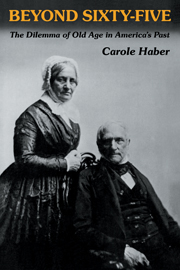Book contents
- Frontmatter
- Contents
- List of Tables
- Acknowledgments
- INTRODUCTION: Classifying Society's Superannuated
- CHAPTER ONE Aging in Colonial America
- CHAPTER TWO Social Realities and Perceptions of Old Age in the Nineteenth Century
- CHAPTER THREE Medical Models of Growing Old
- CHAPTER FOUR Treating the Postclimacteric Stage
- CHAPTER FIVE Institutionalizing the Elderly
- CHAPTER SIX The Pension Barrier
- CONCLUSION: Old Age in a Bureaucratic Society
- Notes
- A Note on Secondary Sources
- Index
CHAPTER THREE - Medical Models of Growing Old
Published online by Cambridge University Press: 26 February 2010
- Frontmatter
- Contents
- List of Tables
- Acknowledgments
- INTRODUCTION: Classifying Society's Superannuated
- CHAPTER ONE Aging in Colonial America
- CHAPTER TWO Social Realities and Perceptions of Old Age in the Nineteenth Century
- CHAPTER THREE Medical Models of Growing Old
- CHAPTER FOUR Treating the Postclimacteric Stage
- CHAPTER FIVE Institutionalizing the Elderly
- CHAPTER SIX The Pension Barrier
- CONCLUSION: Old Age in a Bureaucratic Society
- Notes
- A Note on Secondary Sources
- Index
Summary
The late-nineteenth-century physician who wrote about old age had few medical traditions on which to base his work. Prior to the nineteenth century, medical practitioners did not prescribe specifically for the old. They treated most adults alike, with little regard for chronological age. Even a century later, a specialization in the diseases of senescence couid hardly be considered well established; no medical school offered courses on the aged, nor did some prestigious journals publish the latest findings in gerontological research. The term geriatrics, in fact, did not enter the medical lexicon until 1909, Compared with such popular specializations as gynecology, pediatrics, or surgery, the study of the illnesses of the old attracted little official recognition.
This does not mean, however, that doctors had little to say about the nature of old age. Throughout the nineteenth century, physicians discussed the importance of studying senescence, in order both to understand the dynamics behind growing old and to offer the elderly sufficient therapeutic care. As we shall see, important developments in the theory and practice of medicine had a significant effect upon the physician's perception and treatment of the elderly. By the end of the century, he would view most aged persons – not only the chronically ill – as patients in need of his constant professional attention. Paradoxically, perhaps, this conception would deter him from specializing in the diseases of old age while leading him to prescribe for every aspect of the senescenfs care. Through articles and texts written for the popular and medical press, he presented a consistent and influential view of the needs and abiliries of the elderly.
- Type
- Chapter
- Information
- Beyond Sixty-FiveThe Dilemma of Old Age in America's Past, pp. 47 - 63Publisher: Cambridge University PressPrint publication year: 1983

